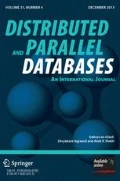Abstract
In a wireless environment, the bandwidth of the channels and the energy of the portable devices are limited. Data broadcast has become an excellent method for efficient data dissemination. In this paper, the problem for generating a broadcast program of a set of data items with the associated access frequencies on multiple channels is explored. In our approach, a minimal expected average access time of the broadcast data items is first derived. The broadcast program is then generated, which minimizes the minimal expected average access time. Simulation is performed to compare the performance of our approach with two existing approaches. The result of the experiments shows that our approach outperforms others and is in fact close to the optimal.
Similar content being viewed by others
References
S. Acharya, R. Alonso, M. Franklin, and S. Zdonik, “Broadcast disks: Data management for asymmetric communication environments,” in Proceedings of the ACM International Conference on Management of Data, May 1995, pp. 199–210.
S. Acharya, M. Franklin, and S. Zdonik, “Dissemination-based data delivery using broadcast disks,” IEEE Personal Communications, vol. 2, no. 6, 1995.
S. Acharya, M. Franklin, and S. Zdonik, “Disseminating updates on broadcast disks,” in Proceedings of the VLDB Conference, 1996a, pp. 354–365.
S. Acharya, M. Franklin, and S. Zdonik, “Prefetching from a broadcast disk,” in Proceedings of the IEEE International Conference on Data Engineering 1996b, pp. 276–285, Advanced Applications (DASFAA), Hsinchu, Taiwan, April 1999.
R. Alonso and H. Korth, “Database systems in nomadic computing,” in Proceedings of the ACM International Conference on Management of Data, 1993, pp. 388–392.
T.F. Bowen, G. Gopal, G. Herman, T. Hickey, K.C. Lee, W.H. Mansfield, J. Raitz, and A. Weinrib, “The datacycle architecture,” Communications of the ACM, 1995, pp. 850–857.
A. Bar-Noy, J. Naor, and B. Schieber, “Pushing dependent data in clients-providers-servers systems,” MOBICOM Conference, 2000.
A. Bar-Noy and Y. Shilo, “Optimal broadcasting of two files over an asymmetric channel,” IEEE INFOCOM Conference, 1999.
Y.D. Chung, M.-H. Kim, “QEM: A scheduling method for wireless broadcast data,” in Proceedings of the 6th International Conference on Database Systems for Advanced Applications (DASFAA), Hsinchu, Taiwan, April 1999.
Y.C. Chehadeh, A.R. Hurson, and M. Kavehrad, “Object organization on a single broadcast channel in the mobile computing environment,” Multimedia Tools and Applications, vol. 9, no. 1, 1999.
J. Gray, P. Sundaresan, S. Englert, K. Baclawski, and P.J. Weinberger, “Quickly generating billion-record synthetic databases,” in Proceedings of the ACM International Conference on Management of Data, 1994, pp. 243–252.
J.-L. Huang and M.-S. Chen, “Dependent data broadcasting for unordered queries in a multiple channel mobile environment,” IEEE Transactions on Knowledge and Data Engineering, 2003.
A.R. Hurson, Y.C. Chehadeh, and J. Hannan, “Object organization on parallel broadcast channels in a global information sharing environment,” in Proceedings of the IEEE International Performance, Computing, and Communications Conference, Feb. 2000.
J.-L. Huang, M.-S. Chen, and W.-C. Peng, “Broadcasting dependent data for ordered queries without replication in a multi-channel mobile environment,” in Proceedings of the IEEE International Conference on Data Engineering, Mar. 5–8, 2003.
G. Herman, G. Gopal, K.C. Lee, and A. Weinrib, “The datacycle architecture for very high throughput database systems,” in Proceedings of the ACM International Conference on Management of Data, 1987, pp. 97–103.
C.-H. Hsu, G. Lee, and A.L.P. Chen, “A near optimal algorithm for generating broadcast programs on multiple channels,” ACM CIKM 2001(Tenth International Conference on Information and Knowledge Management).
C.-H. Hsu, G. Lee, and A.L.P. Chen, “Index and data allocation on multiple broadcast channels considering data access frequencies,” International Conference on Mobile Data Management, 2002.
S. Hameed and N. Vaidya, “Efficient algorithms for scheduling data broadcastation,” ACM/Baltzer Wireless Networks, vol. 5, no. 3, pp. 183–193, 1999.
T. Imielinski and B.R. Badrinath, “Data management for mobile computing,” SIGMOD RECORD, vol. 22, no. 1, pp. 34–39, 1993.
S.C. Lo and A.L.P. Chen, “Optimal index and data allocation in multiple broadcast channels,” in Proceedings of the IEEE International Conference on Data Engineering, 2000, pp. 293–302.
G. Lee, S.C. Lo, and A.L.P. Chen, “Data allocation on the wireless broadcast channel for efficient query processing,” IEEE Transaction on Computers Special Section on Data. Management Systems and Mobile Computing, vol. 51, pp. 1237–1252, 2002.
G. Lee and S.-C. Lo, “Broadcast data allocation for efficient access of multiple data items in mobile environments,” ACM/Baltzer Mobile Networks and Applications (MONET), vol. 8, pp. 365–375, 2003.
G. Lee, M.-S. Yeh, S.-C. Lo, and A.L.P. Chen, “A strategy for efficient access of multiple data items in mobile environments,” International conference on mobile data management, 2002.
W.C. Peng and M.S. Chen, “Dynamic generation of data broadcast programs for a broadcast disk array in a mobile computing environment,” in Proceedings of the ACM International Conference on Information and Knowledge Management, Nov. 2000.
K. Prabhakra, K.A. Hua, and J.H. Oh, “Multi-level multi-channel air cache designs for broadcasting in a mobile environment,” in Proceedings of the IEEE International Conference on Data Engineering, 2000, pp. 167–176.
E. Pitoura and G. Samaras, Data Management for Mobile Computing, Kluwer Academic Publishers, 1998.
N. Shivakumar and S. Venkatasubramanian, “Energy-efficient indexing for information dissemination in wireless systems,” ACM Journal of Wireless and Nomadic Application, 1996.
K.L. Tan and B.C. Ooi, “Batch scheduling for demand-driven servers in wireless environment,” Information Sciences, vol. 109, 1998, pp. 281–298.
N. Vaidya and S. Hameed, “Scheduling data broadcast in asymmetric communication environments,” ACM/Baltzer Wireless Networks, vol. 5, no. 3, 1999.
J.W. Wong, “Broadcast delivery,” Proc. of the IEEE, vol. 76, no. 12, 1988, pp. 1566–1577.
W.G. Yee, S.B. Navathe, E. Omiecinski, and C. Jermaine, “Efficient data allocation over multiple channels at broadcast servers,” IEEE Trans. on Computer, 2002, pp. 1231–1236.
Author information
Authors and Affiliations
Corresponding author
Rights and permissions
About this article
Cite this article
Hsu, CH., Lee, G. & Chen, A.L.P. An Efficient Algorithm for Near Optimal Data Allocation on Multiple Broadcast Channels. Distrib Parallel Databases 18, 207–222 (2005). https://doi.org/10.1007/s10619-005-4949-9
Issue Date:
DOI: https://doi.org/10.1007/s10619-005-4949-9




